INSPIRATION FROM THE WISE COUNCIL OF THE INVISIBLES
In memory of Victor Emanuel Bickel (1928 – 2018)
At the end of the 1980s I became acquainted with strange, lyrical images of extraterrestrial worlds drawn by a certain Faroxis. I was touched by the enchanted pictures and so I got in contact with the artist. Letters came, written in a refined, almost mannerist handwriting, which reminded me of feather-light, elegant tracks left behind by a dancing fairy. It was the handwriting of Victor Emanuel Bickel, who hid behind the artist's name Faroxis.
Soon after that our correspondence came to end, as I became very busy with other projects and Victor Emanuel Bickel moved abroad. It was not until almost three decades later that I picked up his trail again, and did everything I could to finally meet him in person. Bickel was already an old man and now lived with his wife in a small town in the tranquil Tösstal valley in Switzerland. Soon I should learn, why the couple had chosen this place as their new home.
I met a mischievously smiling man with a thin long beard and lively watchful eyes, who didn't speak much, but loved to show me his drawings tirelessly. The man that seemed to have become wise about the things of the world and therefore radiated an indomitable serenity was still drawing images of his extraterrestrial visions.
Victor Emanuel Bickel passed away on 19 December 2018. I consider myself fortunate to have met him a few times and to have gained a deeper insight into the way in which he received information and images from another world and thus created works of art.
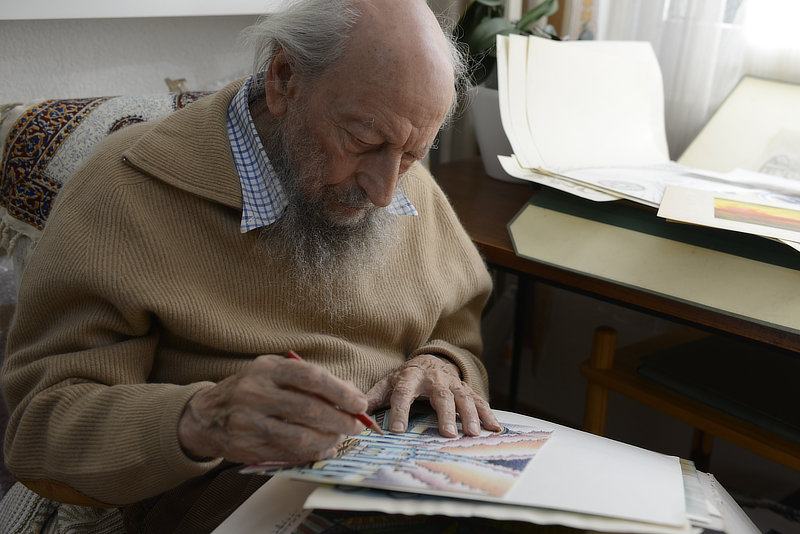 Victor Emanuel Bickel drawing in his small studio, 2016. © Elmar R. Gruber
Victor Emanuel Bickel drawing in his small studio, 2016. © Elmar R. Gruber
Since early childhood Victor Emanuel Bickel wanted to become a painter. As a little boy he loved to draw and paint. But the parents opposed it. Born in 1928 in Augsburg, Germany, two events in his childhood overshadowed Victor Emanuel Bickel's life. At the age of five, he sat on the handlebar of a bicycle that an older friend was riding far too fast. They crashed into a house wall. Victor Emanuel suffered a severe concussion. Awakened from unconsciousness, he did not know if he was alive or dead. Since then he has repeatedly experienced spontaneous altered states of consciousness in which he had the feeling of being in a completely alien world. In jest he later told his friends: "I am not from this world, but come from another planet."
At the age of eleven, he was deeply shocked by the death of his beloved, highly gifted older sister. This event had a lasting impact on Victor Emanuel Bickel. Nevertheless, he kept his cheerfulness throughout his life. Music enjoyed a great tradition in his family. Young Victor Emanuel turned first to the violin, then to the viola. He became a musician. After the war he attended the Munich Academy of Music and was immediately engaged as violist in the Bavarian Radio Symphony Orchestra and became active in three chamber music associations.
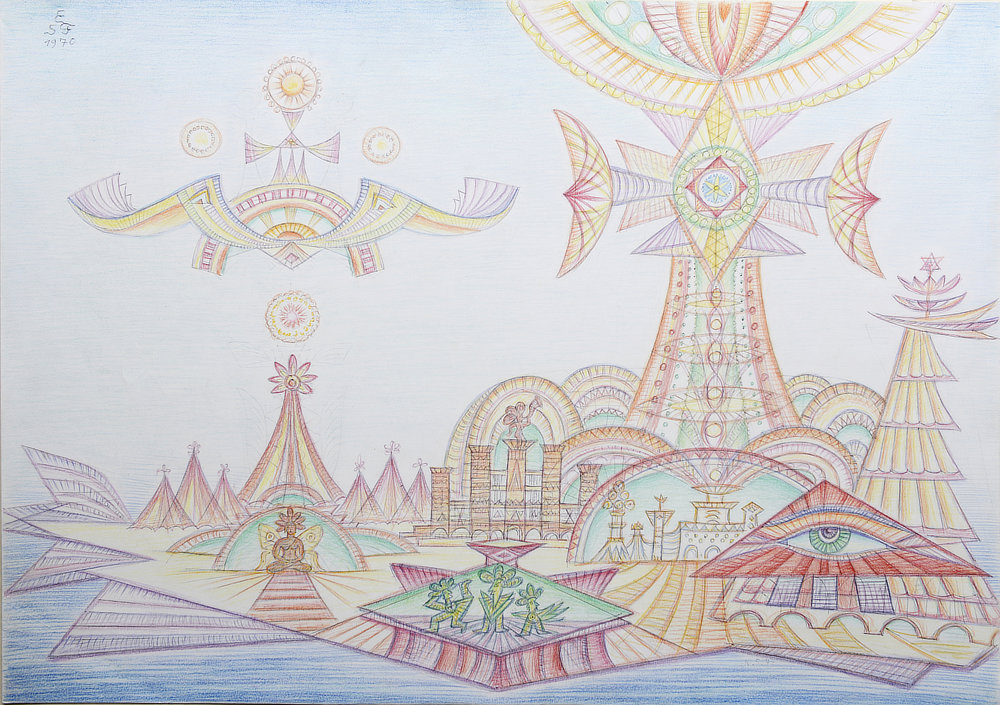 Victor Emanuel Bickel, Untitled, pencil and colored pencil on paper, 1970. © Elmar R. Gruber
Victor Emanuel Bickel, Untitled, pencil and colored pencil on paper, 1970. © Elmar R. Gruber
However, he never neglected drawing and painting. He was a self-taught artist on the side. The strange altered states of consciousness and his unusually intense dreams, in which distant worlds, lost and unknown civilizations played a part, led into a phase of thorough examination of the spiritual traditions of ancient cultures, of philosophy, mysticism and esotericism. He also began to occupy himself intensely with yoga practice. It was during yoga practice that he met his future wife Adelamarie, who shared his interests and who until his passing was the congenial companion at his side.
Through his philosophical and esoteric studies, the style of his drawings and paintings changed markedly. Light, poetic, sometimes playful images emerge in which the happy inhabitants of distant worlds made their appearance. Strange architectures with elements of sunken American and Asian cultures unfold from organic forms embedded in an aura of sceneries reminiscent of science fiction fantasies. Gates stand for passages to other dimensions. Old and future or alien cultures blend into a utopian world in which people and superhuman beings exist in a harmonious union.
What sometimes seems to appear naive or reminiscent of fairy tales are light, melodically flowing and poetic compositions. Not only the figures seem to move like dancers, the fine lines themselves, with which Victor Emanuel Bickel build up his drawings, shimmer and oscillate as if they were vibrated by solemn hymns or chorales. Bickel developed a subtle painting technique with pencils, crayons, chalks and ballpoint pens, through which delicate, pastel-colored but also color-saturated works appear weightless – almost of aeolian transparency. For his alien pictorial worlds, he gave himself a suitable artist’s name. From now on he signed his works Faroxis, or Seraphinus Faroxis, sometimes simply with his middle name Emanuel.
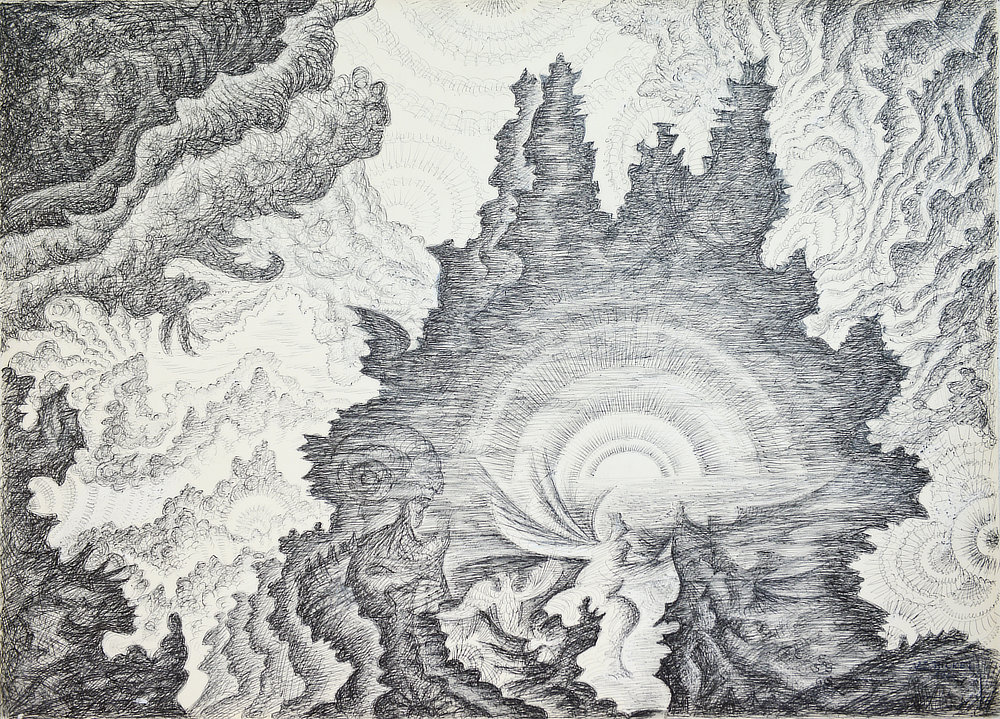 Victor Emanuel Bickel, Untitled, graphite on paper, 1970 © Elmar R. Gruber
Victor Emanuel Bickel, Untitled, graphite on paper, 1970 © Elmar R. Gruber
At the age of 50 his career as a musician came to an abrupt end. During rehearsals for a Bruckner symphony he suffered acute hearing loss. Bickel was forced to retire early. But even with this stroke of fate he did not lose his confidence. He maintained his cheerful serenity and from then on devoted himself entirely to drawing and painting.
His works radiate a mystical aura but without any gloominess or heaviness. There's nothing depressing about them. Rather, they convey the idea of gradual elimination of gravity. Figures don't walk, they float. Everything is filled with radiant effortlessness. People and devices move with the weight of thoughts. For Victor Emanuel Bickel, his drawings ought to reveal a movement towards a higher level of humanity. The evolution of consciousness, the inner becoming is the leitmotif of his works. The longing for a spiritual evolution of man. That's why he never considered his drawings and paintings really completed. He often revised them even years later, cut out an element and glued in a new one or drew the same subject again and again in many variations. The message contained in the works matured within him over time.
Eventually, in the writings of "Billy" Eduard Albert Meier (BEAM), a UFO contactee and author of numerous books and writings, Bickel and his wife found answers to this intuitively grasped evolution of human consciousness and also answers to much in his artistic work that was still puzzling him. The teachings by Billy Meier on the essence of the universe and life were overwhelming for them. They finally had arrived at their inner destination and decided to move to Switzerland, to live close to Billy Eduard Albert Meier and his "Freie Interessengemeinschaft für Grenz- und Geisteswissenschaften und Ufologiestudien" (FIGU, Free Community of Interests in Border Sciences, Liberal Arts, and Ufological Studies).
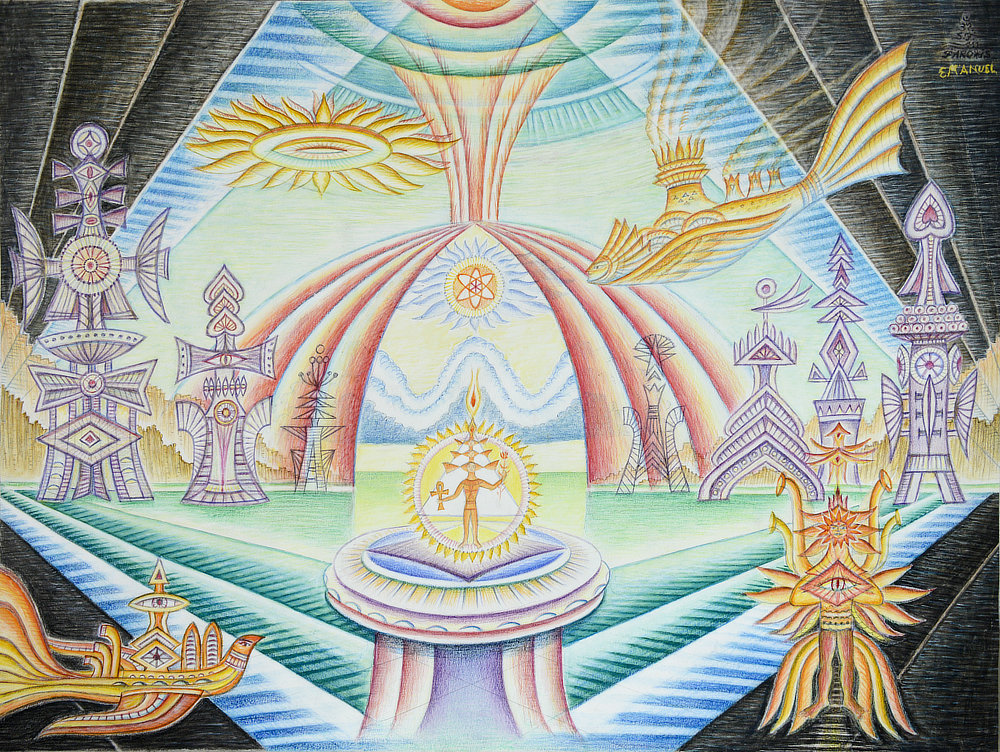 Victor Emanuel Bickel, Untitled, graphite and colored pencil on paper, 1968 © Elmar R. Gruber
Victor Emanuel Bickel, Untitled, graphite and colored pencil on paper, 1968 © Elmar R. Gruber
In the rural seclusion Bickel continued to draw impressions from the outer space of mind. Not as an objective observer or commentator, but as part of the scenery presented. As if he had lived exactly there before or would exist there in a parallel universe. He didn’t feel he's chosen his subjects. His subjects had chosen him to be captured on paper. Bickel smiled mischievously when he asked me the rhetorical question where all these ideas that are revealed in his drawings and paintings come from. He didn’t like to talk about his art. He preferred to leave the speaking to his works. His wife said about him: "Victor is limitless in the sense that he is somehow not restricted in his thinking. For him, anything is possible."
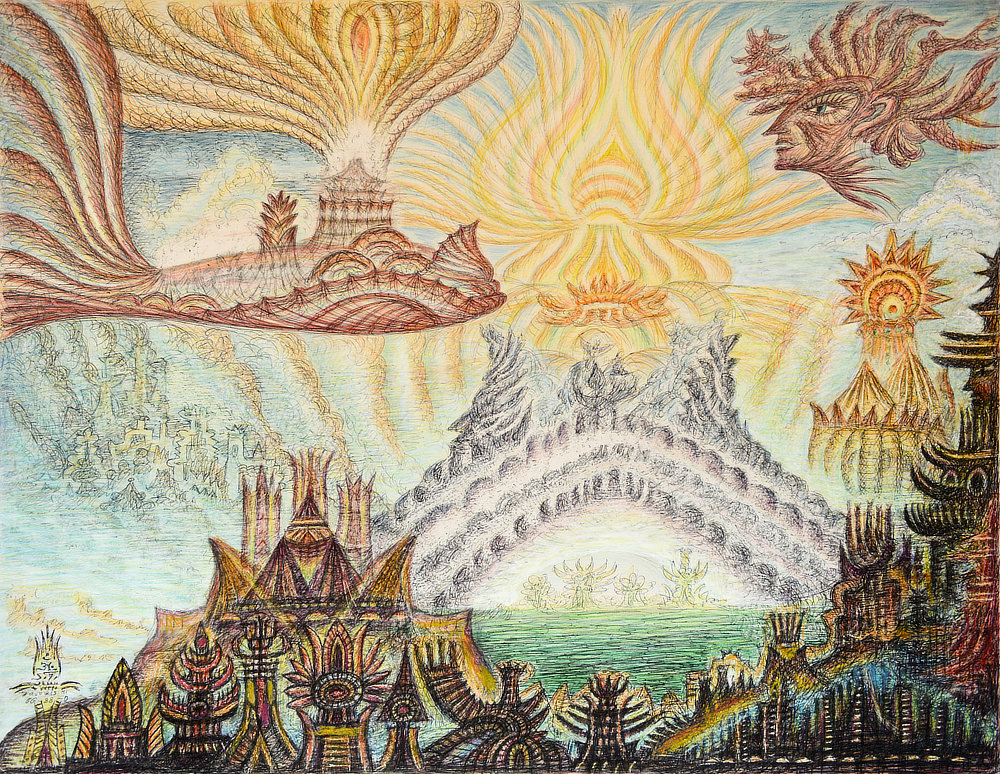 Victor Emanuel Bickel, Untitled, ballpoint pen, colored pencil and oil pastels on paper, 1966-68. © Elmar R. Gruber
Victor Emanuel Bickel, Untitled, ballpoint pen, colored pencil and oil pastels on paper, 1966-68. © Elmar R. Gruber
Bickel wrote poems too and these contain references to how the pictorial worlds came to him and how he expressed them. In his poems he spoke of "the mysterious visions" to which he surrendered, he spoke of the "mysteriously sunken temple" which rests deeply in the "inner seabed of night consciousness". Through these visions one can awaken the wealth of experience of "innumerable incarnations". He received images "from the Wise Council of the Invisibles". In this way, his intuition of the roots of humanity and the reality of other worlds gradually became certainty to him. Guided by angels and messengers of the gods, he recognized the stars as his ancient homeland. Once he described a visionary journey in apocalyptic imagery, from which at the end a "goddess of death" is being transformed into a loving goddess of the new golden age.
In one poem, he wrote that he wants to discard "the wild spirit" that binds us to the outer world so that the "timeless angelic soul" may shine. Like William Blake, he hoped to be spared the deceptive power of the physical eye and gain that mystical insight into the true essence of things when human imagination is no longer limited by the senses.
© 2019 Elmar R. Gruber
